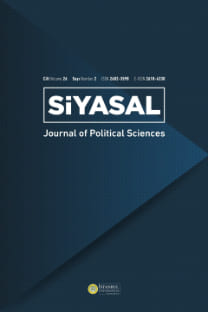Mısır'da ekonomik kalkınma çabaları
Attempts at economic development in Egypt
___
- - Abdel-Fadil, Mahmoud, Development, Income Distribution and Social Change in Rural Egypt, 1952-70: A Study in the Political Economy of Agrarian Development, Cambridge: Cambridge University Press, 1976.
- - Ayubi, Nazih, Over-Stating the Arab State – Politics and Society in the Middle East, London: I.B.Tauris, 1996.
- - Dessouki, Hilal, “External Factors and Development in Egypt,” DanTschirgi (der.) Development in the Age of Liberalization: Egypt and Mexico, Cairo: American University in Cairo Press.1996.
- - Dodge, Toby, “Bringing the Bourgeoisie Back In”, Toby Dodge ve Richard Higgot (der.) Globalization in the Middle East – Economy, society and Politics, London: Royal Institute of International Affairs, 2002.
- - Henry, Clement ve Robert Springborg, Globalization and the Politics of Development in the Middle East, Cambridge: Cambridge University Press, 2001.
- - Hinnebusch, Raymond, ‘The Politics of Liberalisation: Comparing Egypt and Syria’, Hassan Hakimian ve Ziba Moshaver (der.) The State and Global Change – The Political Economy of Transition in Middle East and North Africa, Richmond: Curzon Press, 2001, ss. 111-134.
- - Ikram, Khalid, The Egyptian Economy 1952-2000 – Performance Policies and Issues, Routledge Studies in Middle Eastern Economies, Oxon: Routledge, 2006.
- - Mead, Donald C., Growth and Structural Change in the Egytian Economy, Homewood: R.D.Irwin, 1967.
- - Pamuk, Sevket and Roger Owen, A History of Middle East Economies in Twentieth Century, London: I.B.Tauris, 1998.
- - Richards, Alan and John Waterbury, A Political Economy of the Middle East, Colorado: Westview Press, 1998.
- - Roussillon, Alain, “Republican Egypt Interpreted – Revolution and Beyond”, M.V.Daly (der.) Cambridge History of Egypt , Cilt 2, Cambridge: Cambridge University Press, 2008, ss.334-393.
- - Scobie, Grant McDonald, Government Policy and Food Imports: The Case of Wheat in Egypt, Washington, DC: International Food Policy Research Institute, 1981.
- - Waterbury, John, The Egypt of Nasser and Sadat – The Political Economy of Two Regimes, New Jersey: Princeton University Press, 1983.
- - Zaaluk, Malak, Power, Class and the New Capital in Egypt – The Rise of the New Bourgeoisie, London: Zed Books, 1989.
- ISSN: 1303-1260
- Yayın Aralığı: 2
- Yayıncı: İstanbul Üniversitesi
Uluslararası insancıl hukuk ve İsrail'in Gazze harekatı
Doğu Avrupa'da radikal neo-liberal dönüşüm
Mısır'da ekonomik kalkınma çabaları
Demokrasi ve istikrar açısından parlamenter ve başkanlık hükümet şekli karşılaştırılması
"Bağlantısız üçüncü dünya" dan "çevre ülkeleri"ne
Küresel kalkınma paradigmasının evriminde kurumsal etkenler ve dünya bankası
Siyasi partilere hazine yardımı: Sosyolojik bir değerlendirme
